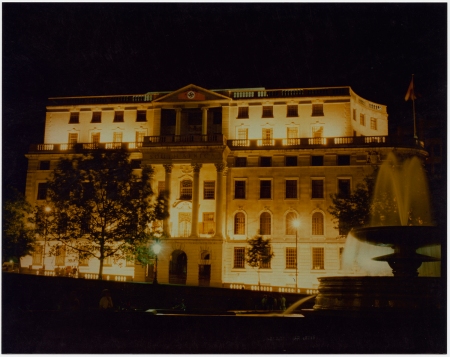Dispatch: Cloth, print and the political
threewalls
Exhibition: February 20th – March 27th, 2009
In conjunction with the Southern Graphics Council Conference, threewalls is hosting an exhibition of political prints on cloth and we’re looking for your DIY election T-shirts!
The T-shirt, arguably considered an American invention, insofar as it is worn as one’s primary garment, and not an undershirt, became a substrate for advertising and political support in the 1950s. Since then it has played an invaluable role in the promotion of politics, sub-culture, music, leisure activities, businesses, sports team, personal slogans and more. The T-shirt is the walking, talking billboard – and probably still the most effective and inexpensive way to get a message out!
Perhaps in concert, printmaking and DIY are experiencing a significant revival. As an inexpensive medium for mass-producing a message or artwork, the hand-pulled print is making a major re-appearance as the most distinct way to promote bands, indie-movies, craft fairs, art events, book releases and rallies. The silk-screened T-shirt shares this appeal. As the election year heated up, the number of small-run T-shirts, printed by individual crafters and print collectives or one-offs by artists, designers or hobbiests ballooned. Nothing could be more American about the T-shirt as a vehicle for rhetoric: casual, commercial and accessible.
Dispatch is an exhibition of grass-roots political efforts, the millennial DIY ethic, micro-capitalism and the intersection between the commercial and craft in print media. As a document of the hundreds of T-shirts that were designed and printed by individuals (for their own use or to sell at craft fairs or raise money for campaigns), Dispatch makes visible, en masse, both the artistry and sheer multitude of designs that were made in support of the 2008 presidential and associated campaigns.
Chicago, both the root of the president-elect Obama’s campaign and a city with a strong grass-roots ethic in both the arts and politics, is a natural host to this exhibition. Dispatch draws on this, celebrating both the artistry and efforts of these makers, while drawing attention to how artwork and micro-industry became both an important form of participation in the millennial political process as well as a highlighting how the 2008 presidential campaign both appealed to and drew on millennial DIY culture.
As a companion to the exhibition and archive of the work, a catalog of the work featured at the gallery, with profiles and stories on a selection of artists about their prints, why they made them, where they wore them and how their garments may have made an impact on their community will be available.
Please submit designs made to support your candidate for office or made as political commentary during the primaries or the general election about the candidates, the election or the policies being discussed. Jpegs should be sent by January 15th, 2009 to Shannon Stratton at shannon@three-walls.org with your contact information and a short description of your T-shirt: where it was made, how many you made, how often you wore it, if you gave away or sold any of the shirts.
threewalls is a nonprofit 501(c)3 organization dedicated to contemporary art practice and discourse. Through the residency program(s), SOLO project and quarterly publication Paper and Carriage, threewalls aims to provide opportunities for experimentation, chance, critical dialogue and context for artists, curators and writers who are at pivotal points in their careers.
Shannon Stratton
Director and Chief Curator of Programs
ThreeWalls
119 N Peoria 2D
Chicago, IL
312-432-3972



